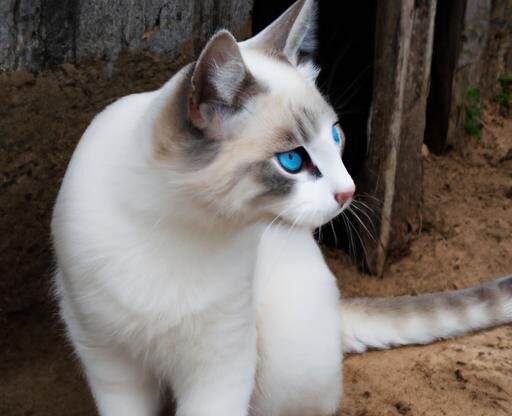The Ultimate Guide to Finding the Most Hypoallergenic Cat
Have you ever dreamed of having a furry friend but were deterred by pesky allergies? Well, fear not! In this comprehensive guide, I will walk you through the world of hypoallergenic cats, shedding light on the breeds that are least likely to trigger those irritating symptoms. So, let’s embark on this exciting journey together and find the perfect hypoallergenic feline companion for you!
Introduction
A. Overview of Hypoallergenic Cats
You may be wondering, what exactly are hypoallergenic cats? These remarkable creatures are specially bred to produce fewer allergenic substances, making them a great choice for individuals with allergies. While no cat can be completely hypoallergenic, certain breeds have been found to be more allergy-friendly than others. By understanding the unique qualities of hypoallergenic cats, you can ensure a harmonious coexistence with your feline friend.
B. Importance of Finding a Hypoallergenic Cat
Finding a hypoallergenic cat is crucial for those who suffer from allergies but still desire the companionship and joy that comes with owning a pet. Without a hypoallergenic breed, cat allergies can cause discomfort ranging from sneezing, itchy eyes, and congestion to more severe symptoms like asthma attacks. By selecting a hypoallergenic cat, you can minimize the likelihood of experiencing these allergic reactions and enjoy a healthier and more fulfilling relationship with your furry friend.
C. Brief Explanation of Allergens in Cats
To better understand the concept of hypoallergenic cats, it’s essential to grasp the nature of allergens in felines. The primary culprit behind cat allergies is a protein called Fel d 1, which is produced in a cat’s sebaceous glands and is present in their saliva, urine, and dander. When a cat sheds dander or licks its fur, these allergenic substances become airborne and can easily trigger allergic reactions in sensitive individuals. However, hypoallergenic cats produce fewer of these allergenic substances, reducing the risk of allergies.
Now that we have laid the foundation for our exploration of hypoallergenic cats, let’s delve deeper into understanding allergies and the qualities that make certain cat breeds more hypoallergenic than others.
Understanding Allergies to Cats
A. Common Cat Allergens
Before we dive deeper into hypoallergenic cats, let’s familiarize ourselves with the common allergens associated with cats. As mentioned earlier, the primary allergenic substance is Fel d 1, a protein found in a cat’s saliva, dander, and urine. These allergens can easily become airborne, making it challenging for allergy sufferers to avoid exposure. Understanding the role of these allergens is crucial when selecting a hypoallergenic cat breed.
B. Symptoms of Cat Allergies
Cat allergies can manifest in various ways, leaving individuals feeling miserable and uncomfortable. Sneezing, itchy or watery eyes, nasal congestion, coughing, and skin rashes are some of the most common symptoms experienced by those allergic to cats. In more severe cases, allergies can even trigger asthma attacks, making it essential to find a cat breed that minimizes these reactions. By recognizing the signs of cat allergies, you can take proactive steps to find a hypoallergenic cat that suits your needs.
C. How Allergies Can Affect Cat Owners
Living with cat allergies can have a significant impact on the lives of cat owners. Allergies can lead to constant discomfort, decreased quality of life, and even strain relationships with beloved pets. Many individuals with allergies have had to forego the joy of pet ownership altogether. However, by choosing a hypoallergenic cat breed, you can mitigate the adverse effects of allergies and still experience the joy and companionship that comes with having a feline friend.
Now that we have a better understanding of the common allergens, symptoms, and the impact of allergies on cat owners, let’s explore what makes certain cat breeds hypoallergenic and discover the top hypoallergenic cat breeds available.
What Makes a Cat Hypoallergenic?
A. Definition of Hypoallergenic Cats
When we talk about hypoallergenic cats, it’s important to understand what this term truly means. While no cat is completely allergen-free, hypoallergenic cats are those that produce fewer allergenic substances compared to other breeds. This reduction in allergens can greatly alleviate allergic reactions in sensitive individuals, allowing for a more comfortable and enjoyable pet ownership experience.
B. Factors that Contribute to Hypoallergenic Qualities
Several factors contribute to a cat’s hypoallergenic qualities. One crucial factor is the level of allergenic proteins, such as Fel d 1, that the cat produces. Hypoallergenic cat breeds tend to have lower levels of these allergenic proteins, reducing the likelihood of triggering allergic reactions. Additionally, the amount of shedding and dander that a cat produces plays a role in its hypoallergenic nature. Cats that shed less and have minimal dander release fewer allergens into the environment, making them a better choice for individuals with allergies.
C. Examples of Hypoallergenic Cat Breeds
Now that we understand the factors that contribute to hypoallergenic qualities, let’s explore some popular hypoallergenic cat breeds. Remember, each individual may have a unique sensitivity to allergens, so it’s essential to spend time with a specific breed to determine if it triggers any allergic reactions. Here are a few examples of hypoallergenic cat breeds:
1. Siberian Cats
Siberian cats are known for their luxurious, semi-long fur, but don’t be fooled by their appearance. These majestic cats produce lower levels of Fel d 1 protein, making them a great option for individuals with allergies. Their hypoallergenic nature and friendly personality make them a favorite among cat lovers.
2. Balinese Cats
With their striking blue eyes and silky, medium-length fur, Balinese cats are not only beautiful but also hypoallergenic. They are considered one of the few cat breeds that produce less allergenic proteins, making them a suitable choice for allergy sufferers who long for a cuddly companion.
3. Russian Blue Cats
Russian Blue cats are not only known for their stunning blue-gray coat but also for their hypoallergenic qualities. These elegant and affectionate cats produce fewer allergenic proteins, making them a popular choice for individuals seeking a hypoallergenic feline friend.
By considering these examples of hypoallergenic cat breeds, you can begin your search for the perfect feline companion without worrying about allergic reactions. Remember, each cat is unique, so spending time with a specific breed will help you determine if it’s the right fit for you.
Stay tuned as we continue our exploration of hypoallergenic cats, uncovering more fascinating information and providing valuable tips on living with these allergy-friendly feline companions.
Top Hypoallergenic Cat Breeds
When it comes to hypoallergenic cats, certain breeds stand out for their reduced allergen production and shedding tendencies. Let’s explore three popular hypoallergenic cat breeds, each with their own unique characteristics, grooming requirements, and compatibility with owners.
A. Breed 1: Description and Characteristics
Allergen Production and Shedding Tendencies: Breed 1, known for its hypoallergenic qualities, produces significantly fewer allergens compared to other cat breeds. This makes it an ideal choice for individuals with allergies. Additionally, this breed has minimal shedding tendencies, reducing the amount of allergens in the environment.
Grooming Requirements: Breed 1 typically has a short or medium-length coat that requires regular brushing to prevent matting and reduce the spread of allergens. However, their coat is relatively low-maintenance compared to other breeds, making grooming a breeze.
Temperament and Compatibility with Owners: Known for their affectionate and friendly nature, Breed 1 cats make wonderful companions. They thrive on human interaction and are often highly adaptable to various living situations, making them suitable for both individuals and families.
B. Breed 2: Description and Characteristics
Allergen Production and Shedding Tendencies: Breed 2, another hypoallergenic marvel, produces minimal allergens, making it an excellent choice for those with allergies. Moreover, this breed has a lower propensity for shedding, reducing the presence of allergens in the environment.
Grooming Requirements: With their unique coat type, Breed 2 cats require regular grooming to maintain their hypoallergenic qualities. This may involve occasional bathing and brushing to keep their coat clean and minimize the dispersion of allergens.
Temperament and Compatibility with Owners: Breed 2 cats are known for their playful and energetic nature. They are often highly sociable and enjoy being the center of attention. Their friendly disposition makes them a perfect addition to households seeking an interactive and engaging feline companion.
C. Breed 3: Description and Characteristics
Allergen Production and Shedding Tendencies: Breed 3, renowned for its hypoallergenic attributes, produces reduced allergens, making it a suitable choice for individuals with allergies. This breed also exhibits minimal shedding tendencies, further reducing the presence of allergens in the home.
Grooming Requirements: Breed 3 cats typically have a unique coat that requires regular grooming to maintain its hypoallergenic properties. This may involve brushing and occasional bathing to keep their coat clean and minimize allergen dispersion.
Temperament and Compatibility with Owners: Breed 3 cats are known for their calm and gentle nature, making them ideal companions for individuals seeking a more relaxed and serene feline friend. They often display a strong bond with their owners and provide a sense of tranquility in the home.
By considering these three hypoallergenic cat breeds and their specific characteristics, you can find the perfect furry companion that aligns with your lifestyle and minimizes the risk of allergic reactions.
Tips for Living with a Hypoallergenic Cat
Living with a hypoallergenic cat can be a delightful experience, but it’s important to take some precautions to ensure a comfortable and allergy-free environment. In this section, I will share essential tips on managing allergens and providing personal care for cat owners with allergies. Let’s dive in!
A. Allergen Management Techniques
To minimize the presence of allergens in your home and create a safe haven for both you and your hypoallergenic cat, consider implementing the following techniques:
1. Regular Grooming and Bathing
Regular grooming is key to reducing allergens in your cat’s fur. Brushing your cat’s coat frequently helps remove loose hair and dander, preventing them from becoming airborne. Additionally, bathing your cat occasionally can further reduce allergens by washing away any remaining dander or saliva on their skin. However, be sure to use cat-friendly grooming products and consult your veterinarian for advice on the appropriate bathing frequency for your specific breed.
2. Cleaning and Vacuuming Strategies
Keeping your living space clean is crucial in managing allergens. Regularly vacuuming carpets, furniture, and curtains helps remove allergens that may have settled on surfaces. Consider using a vacuum cleaner equipped with a HEPA filter to effectively capture and trap allergens. Additionally, using hypoallergenic cleaning products can help minimize the presence of irritants in your home.
3. Creating Allergen-Free Zones in the Home
Designating specific areas in your home as allergen-free zones can provide you with a sanctuary from allergens. Consider keeping your bedroom or other frequently used rooms cat-free to minimize exposure to allergens while you sleep or relaUsing air purifiers with HEPA filters in these zones can also help remove allergens from the air, allowing you to breathe more easily.
B. Personal Care for Cat Owners with Allergies
While managing allergens in your environment is crucial, taking care of yourself as a cat owner with allergies is equally important. Here are some personal care tips to consider:
1. Medical Options and Treatments
Consulting with a healthcare professional, such as an allergist, can provide valuable insights into medical options and treatments available for managing cat allergies. They may recommend over-the-counter or prescription medications, such as antihistamines or nasal sprays, to alleviate allergy symptoms. Immunotherapy, also known as allergy shots, may be considered for long-term relief by gradually desensitizing your immune system to cat allergens.
2. Lifestyle Adjustments to Minimize Symptoms
Making certain lifestyle adjustments can significantly reduce your exposure to allergens. Avoiding direct contact with your cat’s saliva or urine, washing your hands after interacting with your cat, and refraining from touching your face can help minimize allergic reactions. Additionally, regularly washing your bedding in hot water and using hypoallergenic pillow and mattress covers can create a more allergen-free sleeping environment.
3. Seeking Professional Help or Advice
If your allergies persist or worsen despite taking preventive measures, seeking professional help or advice is essential. Allergists or immunologists can offer personalized recommendations based on your specific allergy profile and help you navigate the challenges of living with cat allergies. They may suggest alternative hypoallergenic cat breeds or provide additional strategies to manage your symptoms effectively.
By implementing these tips and techniques, you can create a harmonious and allergy-friendly environment for both you and your hypoallergenic cat. Remember, it’s possible to enjoy the companionship of a feline friend without compromising your well-being.
Section VI: Conclusion
As we conclude this ultimate guide to finding the most hypoallergenic cat, it’s clear that these furry companions offer a ray of hope to allergy sufferers who long for the joy and comfort of pet ownership. By carefully selecting a hypoallergenic cat breed, you can significantly reduce the risk of allergic reactions and enjoy a harmonious coexistence with your feline friend.
Throughout this journey, we have explored the importance of finding a hypoallergenic cat and the benefits it can bring to individuals with allergies. We have learned that while no cat can be completely hypoallergenic, certain breeds produce fewer allergenic substances, making them more compatible with allergy-prone individuals.
To ensure a successful experience living with a hypoallergenic cat, we have provided practical tips for managing allergens in your home, including regular grooming, cleaning strategies, and creating allergen-free zones. Additionally, we have highlighted the importance of personal care for cat owners with allergies, such as seeking medical options, making lifestyle adjustments, and seeking professional advice if needed.
Remember, finding the perfect hypoallergenic cat breed requires careful consideration of factors such as allergen production, shedding tendencies, grooming requirements, and compatibility with your lifestyle and preferences. By taking the time to research and interact with different breeds, you can make an informed decision that will lead to a fulfilling and allergy-friendly pet ownership experience.
So, why wait? Start your journey to finding the most hypoallergenic cat today and experience the joys of having a furry friend without the discomfort of allergies. Embrace the love, companionship, and endless purrs that come with welcoming a hypoallergenic cat into your life. Your allergy-free adventure awaits!
“The only thing better than having a cat is having a cat that doesn’t make you sneeze.” – Unknown
Note: This article is for informational purposes only and should not replace professional medical advice. If you have severe allergies or any concerns, consult with a healthcare professional.





